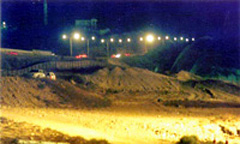 |
 |
 |
 News from Around the Americas | December 2006 News from Around the Americas | December 2006  
Mexican Berm Near Columbus, N.M., Draws Concern
 Associated Press Associated Press


| | The berm also has provided cover for people on the Mexican side who pelted U.S. Border Patrol agents with rocks, and American officials are troubled that the berm was put up without any consultation or planning with the U.S. side. |
Columbus, N.M. — American officials are concerned about a mile-long earthen berm constructed on the Mexican side of the border, apparently in response to flooding in Palomas, Mexico, in August.

The bulldozer-built berm, about 4 feet tall and erected about a month ago, stretches eastward from the Columbus port of entry. It has pushed over fences that divide the two nations and partially buried a cement border monument.

The berm also has provided cover for people on the Mexican side who pelted U.S. Border Patrol agents with rocks, and American officials are troubled that the berm was put up without any consultation or planning with the U.S. side.

A binational group is scheduled to meet today in Columbus to discuss what should be done about the berm, which in a few places has spilled over into the United States.

"We really want to try to meet in an amicable fashion to try to identify a solution," said Sally Spener, public affairs officer for the U.S. section of the International Boundary and Water Commission in El Paso, Texas.

Spener said officials have received only secondhand reports about the berm and their visit will allow them to gather more information. Maintaining the visibility of the buried boundary monument would be a clear-cut goal.

"We have an obligation to maintain the monument, and if we have to move some dirt I think we can do that," she said.

It's not clear who erected the berm, officials said.

Secorro Cordova, spokeswoman for the Mexican consulate in El Paso, said she believed Palomas municipal officials did so to stem run-off from the Florida Mountains that flowed south across the border and inundated the village in August.

Columbus Mayor Eddie Espinoza said about 70 Palomas residents were sheltered in a dance hall during one flooding incident last summer. He said Columbus has several levees on the town's west side to control runoff flowing from the Tres Hermanas Mountains.

Espinoza said he didn't know about the berm until he was contacted about two weeks ago by representatives from the office of U.S. Sen. Jeff Bingaman, D-N.M. Espinoza said his primary concern is that water flows redirected by the berm could affect Columbus.

"By them doing that, I think it might create a problem for us," Espinoza said.

Rick Moody, agent in charge of the Border Patrol's Deming station, said he was concerned the berm could contribute to flooding at the port of entry or, if breached, send a "wall of water" into Palomas.

"I realize what they are trying to do, but it may not be the best way to approach it," Moody said. "Certainly, we don't want to see residents and the community flooded down there, but it's better if we work together."

The berm's height also makes it easier for illegal border crossers to hop over a chain-link fence. In one place, a hole has been cut in the middle of the fence.

Moody said he doesn't believe the berm was erected to hide criminal activity, but he believes "criminals will exploit it."

Town Hall in Palomas was closed Friday and the town's mayor couldn't be reached for comment at his home. A spokesman for the Mexican section of the International Boundary and Water Commission also couldn't be reached for comment.

Cordova said the people who erected the berm should have consulted first with the International Boundary and Water Commission, particularly since the berm sits right upon the border.

"They need to go through international regulations, because it's a federal line," Cordova said. | 
 | |
 |



